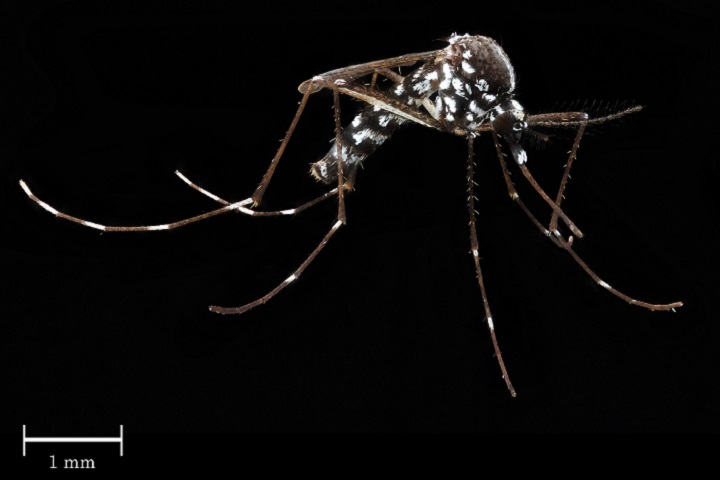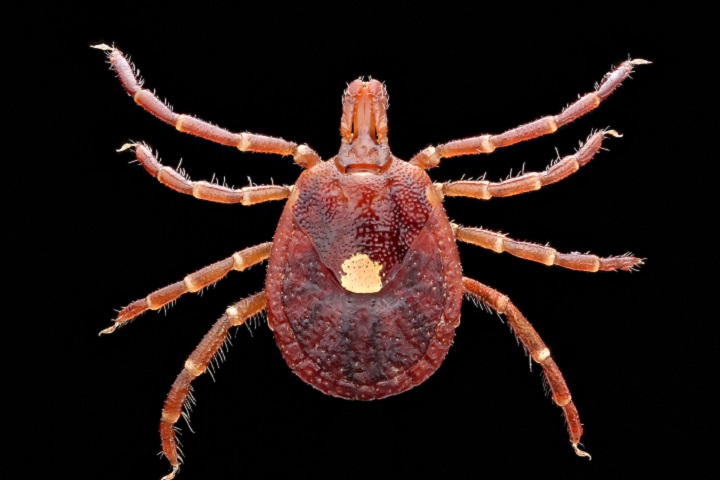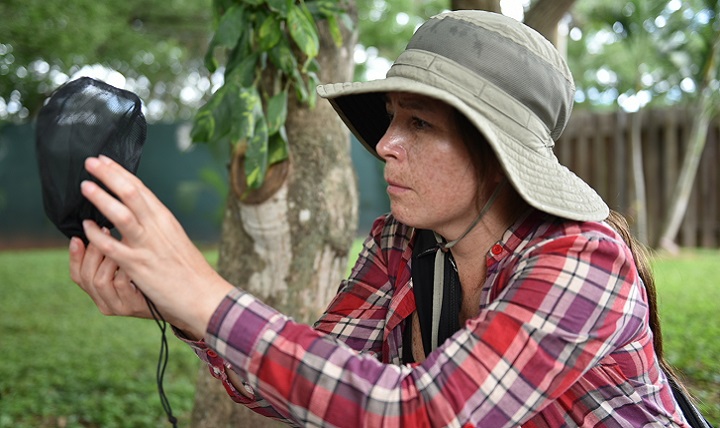
Army invention traps things that go buzz in the day

Aedes albopictus, is one type of mosquito responsible for spreading dengue and yellow fevers as well as the Zika and chikungunya viruses, are common throughout eastern and southern portions of the United States, South America, and other parts of the world. (Courtesy photo)
Some mosquitoes aren’t merely a nuisance. They transmit serious and even deadly maladies to humans through their bites. That’s why Army entomologists invented a device that entices, traps, and then kills two types of adult female mosquitoes and their larvae.
The device is known commercially as Trap-N-Kill. The World Health Organization has recommended it to lower the risk of disease transmission by reducing mosquito populations.
Designed for outdoor use, the trap targets the mosquitoes responsible for spreading dengue and yellow fevers as well as the Zika and chikungunya viruses, among others. Those mosquitoes –Aedes aegypti and Aedes albopictus – are common throughout eastern and southern portions of the United States, South America, and other parts of the world, said Tom Burroughs, chief of the Entomological Sciences Division at the U.S. Army Public Health Center, or APHC.

Trap-N-Kill works by mimicking the mosquitoes’ natural breeding sites.(Courtesy photo)
The mosquitoes bite during daytime hours and breed in outdoor containers with standing water, including flowerpot saucers, birdbaths, and trash can lids. “They can breed in something as small as a bottlecap with a few drops of water in it,” Burroughs said.
Trap-N-Kill works by mimicking the mosquitoes’ natural breeding sites. Users place a plastic pesticide strip inside the approximately 8-inch-tall, cylinder-shaped device and then fill with water. Mosquitoes looking for a place to lay their eggs enter through a small hole in the front. The pesticide strip fatally poisons them and any larvae that hatch from the eggs, Burroughs said. The trap is reusable, but the pesticide strip should be replaced every month and a half.
It takes seven to 10 days for mosquitoes to develop from egg to adult, but Trap-N-Kill’s development cycle was significantly longer, Burroughs said. Two Army entomologists – Brian Zeichner, from APHC’s precursor, the U.S. Army Center for Health Promotion and Preventive Medicine; and Michael Perich, Ph.D., with the Walter Reed Army Institute of Research, or WRAIR – spent more than two decades working on their invention. Originally, it was used to monitor the type and number of mosquitoes in a specific area.
Trap-N-Kill became available to Department of Defense personnel through the military supply system starting in 2014. It’s also available through a commercial licensing agreement at civilian retail locations. APHC and WRAIR jointly hold the patent on the device, Burroughs said.
“We encourage installations and public health staffs to use it in combination with other mosquito-control strategies,” Burroughs said. “The trap reduces the amount of pesticide used and easily integrates into mosquito-management programs, and it can be removed when mosquitoes are no longer a problem.”
APHC offers more information about the Trap-N-Kill online.
Mosquitoes 2018
Video
7/30/2018

MHS observes Bug Week! Learn more about how to stay safe from mosquitoes and the diseases they carry by watching this video.
Fleas 2018
Video
7/30/2018

MHS observes Bug Week! Learn more about how to protect yourself--and your pets--from fleas by watching this video.
Ticks 2018
Video
7/30/2018

MHS observes Bug Week! Learn more about how to keep safe from ticks, and the diseases they carry, by watching this video.
Zika Sexual Transmission 2018
Infographic
7/27/2018

The Zika virus can be spread to sexual partners
Zika Pregnancy 2018
Infographic
7/27/2018

Because Zika can cause certain birth defects, you should take precautions to prevent infection
Travel Health Mosquitoes 2018
Infographic
7/27/2018

Tips to help your trip to be bug bite free
Prevent Bug Borne Illnesses 2018
Infographic
7/27/2018

Tips to keep you bug-borne illness free
Mosquito Bite Prevention 2018
Infographic
7/27/2018

Steps to take to keep from getting bitten by mosquitoes
Help Control Mosquitoes 2018
Infographic
7/27/2018

Tips to keep your community safe from bugs
Anaphylactic Shock 2018
Infographic
7/27/2018

How to prevent allergic reactions from bug bites and stings
Army entomology experts: Don’t get bitten
Article
7/16/2018

The best way to ensure you don't get sick is to not get bitten
Summer Safety 2018 Mosquito Safety
Infographic
6/20/2018

This infographic provides information on ways to protect yourself from harmful mosquito bites.
Surveillance for Vector-Borne Diseases, Active and Reserve Component Service Members, U.S. Armed Forces, 2010 – 2016
Infographic
2/14/2018

This infographic summarizes available health records information about the occurrence of vector-borne infectious diseases among members of the U.S. Armed Forces, during a recent 7-year surveillance period (2010 – 2016).
Joint efforts in search of a cure for tropical diseases
Article
1/11/2018

Malaria. Dengue. Zika.
Air Force launches aerial spray mission against mosquitoes
Article
9/25/2017

The Air Force Reserve’s 910th Airlift Wing continues aerial spray mosquito control application in areas of eastern Texas to assist Hurricane Harvey recovery efforts





















.png)












No hay comentarios:
Publicar un comentario